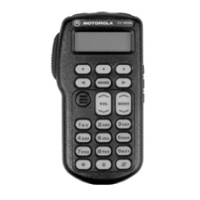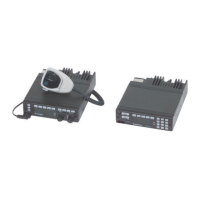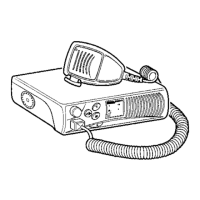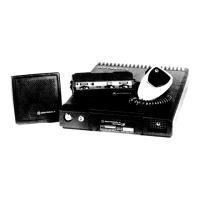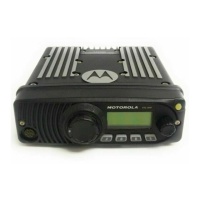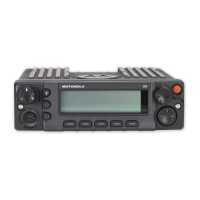49
increments, not in the usual 16. This allows more pre-
cise setting of rated audio, etc. Press HOME to move
the cursor back and forth between the frequency and
signalling type. The first digit will flash to indicate which
type is currently selected. Press Mode to scroll through
the available selections.
When in receive mode, reception of a properly mod-
ulated signal at the proper frequency is indicated by the
radio as follows:
BUSY LIGHT FLASHES - Proper RF frequency
being received with proper signalling types.
BUSY LIGHT STAYS ON - Proper RF frequency
being received.
To check for proper demodulation, apply an RF car-
rier at 1000 microvolts, modulated with the signal
frequency and deviation level indicated in Table 19.
The table also shows which integrated circuit is tested
by the various signalling types.
NOTE
For trunked models, make sure the microphone is
removed from the grounded hangup clip so that the
radio busy light is extinguished before you apply the
signal.
When in transmit mode, DTMF modulation pro-
duces a sidetone in the speaker. All signalling types will
continually modulate the transmitted signal for detec-
tion/measurement by external instruments.
Refer to ALIGNMENT VIA IBM PERSONAL COM-
PUTER paragraph VIII. of this manual for instructions on
adjustment of Touch Code encoder microphone DTMF
modulation level.
To exit the test mode, press Mode and scroll to the
"EXIT” display that follows the last frequency and/or sig-
nalling type. Press HOME to exit and return to the "TST
FREQ” display.
X. CONTROL HEAD TESTING
The control head test mode is part of the diagnos-
tics built into the radio and is entered through the front
panel programming sequence. (See FRONT PANEL
PROGRAMMING AND ADJUSTMENTS of this manual,
and specifically, paragraph XVI. for password entry.)
This test mode allows you to perform button and
display tests to verify proper operation.
Display Modulation Demodulation Type
1. CS None None Carrier Squelch, HearClear Disabled
2. PL 100Hz 100Hz PL
3. PC 11Hz None PL (Compensation Adjust)
4. PD 67Hz None PL (Deviation Adjust)
5. DL 100Hz 100Hz DPL
6. LS 100Hz 100Hz Trunked Low-Speed
7. M6 1500Hz 1500Hz MDC–600
8. MC 1500Hz 1500Hz MDC–1200
9. HS 1500Hz 1500Hz Trunked High-Speed
10. DF 1477 & 941Hz None DTMF Digit #
11. HC None None Carrier Squelch, HearClear Enabled
Table 18. Signalling Types
NOTES:
1. HearClear always disabled during test mode except on “HC” signalling type.
2. Adaptive splatter feature always disabled.
3. Sine waves used for trunked, MDC, and DPL signalling modulation/demodulation rather than actu-
al data signalling.
4. Volume level is 256 steps versus normal 16 to aid in setting rated audio level.
5. Transmitter time-out timer is disabled.
6. Microphone audio is disabled during MDC, DTMF, and trunked high-speed modulation.
7. Synthesizer always in narrowband configuration during transmit.
8. “Normal” radio operation is disabled (i.e., cannot initiate or receive calls, edit operator selectable
scan list, etc.)
9. For trunked radios, place the microphone in the hangup clip (grounded) while in the “TEST FRE-
QUENCY” menu to unsquelch the radio and allow receiver measurements to be made.
Signalling Modulation Deviation IC
Type Frequency Level Tested
Trunking High-Speed 1500Hz 690Hz Signalling Filter (SFIC)
Trunking Low-Speed 100Hz 250Hz Signalling Filter (SFIC)
MDC–600/MDC–1200 1500Hz 880Hz Signalling Filter (SFIC)
PL/DPL 100Hz 250Hz Audio Filter (AFIC)
Table 19. Checking Modulation Frequency and Deviation

